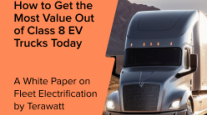E&MU: Electric Trucks Reach the Market
By Mindy Long, Contributing Writer, Special to E&MU
This story appears in the May/June 2011 issue of Equipment & Maintenance Update, a supplement to the May 16 print edition of Transport Topics. Click here to subscribe today.
It appears that the time for electric commercial trucks has arrived. After years of announcements promoting concepts and prototypes, several suppliers have introduced battery-electric production models.
As with other alternative power systems, such as hybrids or natural gas trucks, electric trucks are not the silver bullet that will reduce all of a fleet’s operating costs.
Electric trucks have significant limitations. They cost a lot and have limited operating range, and their power source is a developing technology.
Nevertheless, they may find a home in some fleet and business applications as battery technology evolves and prices fall.
With just a handful of commercial suppliers, the number of available models is low. However, each unit is highly customizable, giving fleets the ability to create vehicles tailored to their operations, industry executives said.
For example, ZeroTruck, Irvine, Calif., starts with the Isuzu N Series chassis, then configures the battery box and body based on a fleet’s payload and range requirements, said Tedd Abramson, president and chief marketing officer.
Smith Electric Vehicles, Kansas City, Mo., manufacturer of the Smith Newton battery-electric truck, offers several different sizes and payloads. “We sell a cabin
chassis, and it can be used on vehicles with boom trucks, shuttle buses or a 24-foot van body,” said Bryan Han-sel, Smith’s CEO.
Freightliner Custom Chassis Corp., Gaff-ney, S.C., and Mor-gan Olson, Sturgis, Mich., have partnered to produce the all-electric MT-EV walk-in van, which will be available later this year.
Ford Motor Co. began production of the Transit Connect Electric truck late last year.
The company plans to follow with the Focus Electric, a plug-in hybrid electric vehicle, in 2011 and next-generation hybrid technology in 2012.
As part of the Navistar-Modec EV Alliance, Navistar International, Warrenville, Ill., began selling the eStar, a Class 2c-3 all-electric truck, in May 2010. In March, U.K.-based Modec entered into administration, which is similar to bankruptcy in the United States.
Navistar spokesman Steve Schrier said he didn’t expect the filing to affect the al-liance’s operations. “NMEVA is a separate legal entity, for which we are a majority owner and have access to the IP and technology we need for competing in North America,” Schrier said.
Some companies also provide the components, allowing fleets to pick and choose the manufacturers they want.
Motiv Power Systems Inc., Foster City, Calif., provides electric drive power control systems that can be used in many applications. “Fleets could still use the chassis and the platform they’re using, but instead of a diesel drive, it would be electric,” said Jim Castelaz, Motiv’s CEO.
Developing a power source with more energy and storage capacity at a lower cost is the holy grail of electric vehicle development and research. Over the past years, companies have committed to investing hundreds of millions of dollars into this quest.
The battery itself can represent up to 40% of an electric truck’s total cost, depending on the size of the truck and its power needs, several manufacturers said. That relative cost can rise to as much as 50% to 70% when it includes the components needed to support the power system, such as the high-voltage wiring, temperature controls and charge management components, said Kris Hus, product manager of commercial chassis with Freightliner Custom Chassis Corp.
Various types of lithium-ion batteries will continue to be the power of choice in electric trucks for several years, Peter Harrop, chairman of IDTechEx, said in an e-mail.
However, Harrop said he expected that solid-state batteries of one sort or another will begin to be used in manned on-road vehicles in about five to 10 years. IDTechEx is a research analysis firm based in Cambridge, Mass.
Fortunately, industry experts said, prices of electric trucks are expected to decrease with time. “We’ve seen the cost of batteries per kilowatt-hour drop significantly over the past two to three years,” said Genevieve Cullen, vice president of the Electric Drive Transportation Association.
While electric vehicles hold a long-term pro-mise of fuel savings and less maintenance, they require a significant upfront cost.
Incentives in the form of tax credits or rebates could help, but there are no federal incentives currently for battery-electric, plug-in hybrid or hybrid vehicles heavier than 14,000 pounds, Cullen said.
In February, Sen. Debbie Stabenow (D-Mich.) introduced the Charging America Forward Act, which would provide up to $7,500 in rebates for plug-in electric vehicles and give businesses a tax credit for purchasing medium- or heavy-duty plug-in hybrid trucks.
At the state level, incentives vary by which state is involved, vehicle size and other criteria.
Smith Electric’s Hansel said fleets will choose to place vehicles where they can get incentives. Smith Newton electric vehicles start between $85,000 and $90,000, but their diesel equivalent averages $65,000. However, in California, buyers can receive a $20,000 voucher for Smith vehicles, and in Oregon, they can take advantage of a tax credit for 35% of the price differential, Hansel said.
Mike O’Connell, national director of fleet capability for Frito-Lay North America, Plano, Texas, acknowledged that incentives are critical in the short term but said Frito-Lay will invest in the technology, even without them. “I now have to buy multiple fluids — diesel and diesel exhaust fluid. It is becoming more and more feasible to do this without grants,” O’Connell said.
Mindy Long is a freelance writer based in Annandale, Va.




